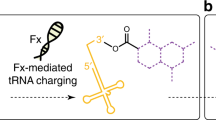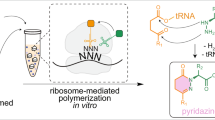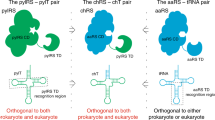Abstract
Translation, the mRNA-templated synthesis of peptides by the ribosome, can be manipulated to incorporate variants of the 20 cognate amino acids. Such approaches for expanding the range of chemical entities that can be produced by the ribosome may accelerate the discovery of molecules that can perform functions for which poorly folded, short peptidic sequences are ill suited. Here, we show that the ribosome tolerates some artificial helical aromatic oligomers, so-called foldamers. Using a flexible tRNA-acylation ribozyme—flexizyme—foldamers were attached to tRNA, and the resulting acylated tRNAs were delivered to the ribosome to initiate the synthesis of non-cyclic and cyclic foldamer–peptide hybrid molecules. Passing through the ribosome exit tunnel requires the foldamers to unfold. Yet foldamers encode sufficient folding information to influence the peptide structure once translation is completed. We also show that in cyclic hybrids, the foldamer portion can fold into a helix and force the peptide segment to adopt a constrained and stretched conformation.
This is a preview of subscription content, access via your institution
Access options
Access Nature and 54 other Nature Portfolio journals
Get Nature+, our best-value online-access subscription
$29.99 / 30 days
cancel any time
Subscribe to this journal
Receive 12 print issues and online access
$259.00 per year
only $21.58 per issue
Buy this article
- Purchase on Springer Link
- Instant access to full article PDF
Prices may be subject to local taxes which are calculated during checkout




Similar content being viewed by others
Change history
31 May 2018
In the version of this Article originally published, in Fig.1f there was an erroneous ‘Gly–Gly’ label placed above the foldamer–peptide structure. Furthermore, in Fig. 2a, the expected target structures from substrates 9 and 10 were inadvertently swapped. These errors have been corrected in the online versions.
References
Fischer, N. et al. Structure of the E. coli ribosome–EF–Tu complex at <3 Å resolution by Cs-corrected cryo-EM. Nature 520, 567–570 (2015).
Ernst, R. J. et al. Genetic code expansion in the mouse brain. Nat. Chem. Biol. 12, 776–778 (2016).
Lajoie, M. J. et al. Genomically recoded organisms expand biological functions. Science 342, 357–360 (2013).
Maini, R. et al. Ribosome-mediated incorporation of dipeptides and dipeptide analogues into proteins in vitro. J. Am. Chem. Soc. 137, 11206–11209 (2015).
Murakami, H., Ohta, A., Ashigai, H. & Suga, H. A highly flexible tRNA acylation method for non-natural polypeptide synthesis. Nat. Methods 3, 357–359 (2006).
Hartman, M. C., Josephson, K., Lin, C. W. & Szostak, J. W. An expanded set of amino acid analogs for the ribosomal translation of unnatural peptides. PLoS One 2, e972 (2007).
Shimizu, Y. et al. Cell-free translation reconstituted with purified components. Nat. Biotechnol. 19, 751–755 (2001).
Rogers, J. M. & Suga, H. Discovering functional, non-proteinogenic amino acid containing, peptides using genetic code reprogramming. Org. Biomol. Chem. 13, 9353–9363 (2015).
Katoh, T., Tajima, K. & Suga, H. Consecutive elongation of d-amino acids in translation. Cell Chem. Biol. 24, 46–54 (2017).
Fujino, T., Goto, Y., Suga, H. & Murakami, H. Reevaluation of the d-amino acid compatibility with the elongation event in translation. J. Am. Chem. Soc. 135, 1830–1837 (2013).
Fujino, T., Goto, Y., Suga, H. & Murakami, H. Ribosomal synthesis of peptides with multiple β-amino acids. J. Am. Chem. Soc. 138, 1962–1969 (2016).
Goto, Y. et al. Reprogramming the translation initiation for the synthesis of physiologically stable cyclic peptides. ACS Chem. Biol. 3, 120–129 (2008).
Ohta, A., Murakami, H., Higashimura, E. & Suga, H. Synthesis of polyester by means of genetic code reprogramming. Chem. Biol. 14, 1315–1322 (2007).
Kawakami, T., Murakami, H. & Suga, H. Ribosomal synthesis of polypeptoids and peptoid–peptide hybrids. J. Am. Chem. Soc. 130, 16861–16863 (2008).
Goto, Y. & Suga, H. Translation initiation with initiator tRNA charged with exotic peptides. J. Am. Chem. Soc. 131, 5040–5041 (2009).
Torikai, K. & Suga, H. Ribosomal synthesis of an amphotericin-B inspired macrocycle. J. Am. Chem. Soc. 136, 17359–17361 (2014).
Passioura, T. & Suga, H. A RaPID way to discover nonstandard macrocyclic peptide modulators of drug targets. Chem. Commun. 53, 1931–1940 (2017).
Terasaka, N., Hayashi, G., Katoh, T. & Suga, H. An orthogonal ribosome–tRNA pair via engineering of the peptidyl transferase center. Nat. Chem. Biol. 10, 555–557 (2014).
Jiang, H., Léger, J. M. & Huc, I. Aromatic δ-peptides. J. Am. Chem. Soc. 125, 3448–3449 (2003).
Boersma, M. D. et al. Evaluation of diverse α/β-backbone patterns for functional α-helix mimicry: analogues of the Bim BH3 domain. J. Am. Chem. Soc. 134, 315–323 (2012).
Fuller, A. A. et al. Evaluating β-turn mimics as β-sheet folding nucleators. Proc. Natl Acad. Sci. USA 106, 11067–11072 (2009).
Walensky, L. D. & Bird, G. H. Hydrocarbon-stapled peptides: principles, practice, and progress. J. Med. Chem. 57, 6275–6288 (2014).
Lao, B. B. et al. In vivo modulation of hypoxia-inducible signaling by topographical helix mimetics. Proc. Natl Acad. Sci. USA 111, 7531–7536 (2014).
Fremaux, J. et al. α-Peptide-oligourea chimeras: stabilization of short α-helices by non-peptide helical foldamers. Angew. Chem. Int. Ed. 54, 9816–9820 (2015).
Cheng, P. N. & Nowick, J. S. Giant macrolactams based on β-sheet peptides. J. Org. Chem. 76, 3166–3173 (2011).
Goodman, C. M., Choi, S., Shandler, S. & DeGrado, W. F. Foldamers as versatile frameworks for the design and evolution of function. Nat. Chem. Biol. 3, 252–262 (2007).
Guichard, G. & Huc, I. Synthetic foldamers. Chem. Commun. 47, 5933–5941 (2011).
Gillies, E. R., Deiss, F., Staedel, C., Schmitter, J. M. & Huc, I. Development and biological assessment of fully water-soluble helical aromatic amide foldamers. Angew. Chem. Int. Ed. 46, 4081–4084 (2007).
Delaurière, L. et al. Deciphering aromatic oligoamide foldamer–DNA interactions. Angew. Chem. Int. Ed. 51, 473–477 (2012).
Kudo, M., Maurizot, V., Kauffmann, B., Tanatani, A. & Huc, I. Folding of a linear array of α-amino acids within a helical aromatic oligoamide frame. J. Am. Chem. Soc. 135, 9628–9631 (2013).
Hu, X., Dawson, S. J., Nagaoka, Y., Tanatani, A. & Huc, I. Solid-phase synthesis of water-soluble helically folded hybrid α-amino acid/quinoline oligoamides. J. Org. Chem. 81, 1137–1150 (2016).
Saito, H., Kourouklis, D. & Suga, H. An in vitro evolved precursor tRNA with aminoacylation activity. EMBO J. 20, 1797–1806 (2001).
Goto, Y., Ashigai, H., Sako, Y., Murakami, H. & Suga, H. Translation initiation by using various N-acylaminoacyl tRNAs. Nucleic Acids Symp. Ser. 50, 293–294 (2006).
Goto, Y., Murakami, H. & Suga, H. Initiating translation with d-amino acids. RNA 14, 1390–1398 (2008).
Qi, T. et al. Solvent dependence of helix stability in aromatic oligoamide foldamers. Chem. Commun. 48, 6337–6339 (2012).
Delsuc, N. et al. Kinetics of helix-handedness inversion: folding and unfolding in aromatic amide oligomers. ChemPhysChem 9, 1882–1890 (2008).
Voss, N. R., Gerstein, M., Steitz, T. A. & Moore, P. B. The geometry of the ribosomal polypeptide exit tunnel. J. Mol. Biol. 360, 893–906 (2006).
Sánchez-García, D. et al. Nanosized hybrid oligoamide foldamers: aromatic templates for the folding of multiple aliphatic units. J. Am. Chem. Soc. 131, 8642–8648 (2009).
Baptiste, B., Douat-Casassus, C., Laxmi-Reddy, K., Godde, F. & Huc, I. Solid phase synthesis of aromatic oligoamides: application to helical water-soluble foldamers. J. Org. Chem. 75, 7175–7185 (2010).
Cabrita, L. D. et al. A structural ensemble of a ribosome–nascent chain complex during cotranslational protein folding. Nat. Struct. Mol. Biol. 23, 278–285 (2016).
Nilsson, O. B. et al. Cotranslational protein folding inside the ribosome exit tunnel. Cell. Rep. 12, 1533–1540 (2015).
Dolain, C. et al. Solution structure of quinoline- and pyridine-derived oligoamide foldamers. Chemistry 11, 6135–6144 (2005).
Solà, J., Helliwell, M. & Clayden, J. N- versus C-terminal control over the screw-sense preference of the configurationally achiral, conformationally helical peptide motif Aib8GlyAib8. J. Am. Chem. Soc. 132, 4548–4549 (2010).
Kendhale, A. M. et al. Absolute control of helical handedness in quinoline oligoamides. J. Org. Chem. 76, 195–200 (2011).
Li, J. et al. An in-tether sulfoxide chiral center influences the biophysical properties of the N-capped peptides. Bioorg. Med. Chem. 25, 1756–1761 (2017).
Kodan, A. et al. Structural basis for gating mechanisms of a eukaryotic P-glycoprotein homolog. Proc. Natl Acad. Sci. USA 111, 4049–4054 (2014).
Yu, H. et al. Macrocycle peptides delineate locked-open inhibition mechanism for microorganism phosphoglycerate mutases. Nat. Commun. 8, 14932 (2017).
Gillies, E. R., Dolain, C., Léger, J. M. & Huc, I. Amphipathic helices from aromatic amino acid oligomers. J. Org. Chem. 71, 7931–7939 (2006).
Acknowledgements
This work was mainly supported by a joint ANR-JST grant (ANR-14-JTIC-2014-003 and JST-SICORP, to H.S. and I.H.), and partly supported by the European Research Council under the European Union’s Seventh Framework Programme (ERC-2012-AdG-320892 to I.H.), a Japan Society for the Promotion of Science post-doctoral fellowship (P13766, to J.M.R.) and the Basic Science Research Program through the National Research Foundation of Korea (NRF) funded by the Ministry of Education (2016R1A6A3A03006364, to S.K). This work benefited from the facilities and expertise of the Biophysical and Structural Chemistry platform at IECB, CNRS UMS3033, INSERM US001, Bordeaux University, France.
Author information
Authors and Affiliations
Contributions
S.K. and J.M.R. contributed equally to this work. S.K. and S.J.D. synthesized new compounds. S.K. carried out solution conformational studies. J.M.R. performed in vitro aminoacylation and translation experiments. P.K.M. carried out crystallographic studies. All authors contributed to designing the research, to discussing the results and to writing the manuscript.
Corresponding authors
Ethics declarations
Competing interests
The authors declare no competing interests.
Additional information
Publisher’s note: Springer Nature remains neutral with regard to jurisdictional claims in published maps and institutional affiliations.
Supplementary information
Supplementary Information
Supplementary Figs. 1–35, Supplementary Methods and data
Supplementary Movie 1
Crystal structure of macrocyclic foldamer-peptide hybrid 17
Crystallographic data
Crystallographic data for compound 17, CCDC reference 1554263
Rights and permissions
About this article
Cite this article
Rogers, J.M., Kwon, S., Dawson, S.J. et al. Ribosomal synthesis and folding of peptide-helical aromatic foldamer hybrids. Nature Chem 10, 405–412 (2018). https://doi.org/10.1038/s41557-018-0007-x
Received:
Accepted:
Published:
Issue Date:
DOI: https://doi.org/10.1038/s41557-018-0007-x
This article is cited by
-
A versatile living polymerization method for aromatic amides
Nature Chemistry (2021)
-
Ribosome-mediated polymerization of long chain carbon and cyclic amino acids into peptides in vitro
Nature Communications (2020)
-
Expanding the limits of the second genetic code with ribozymes
Nature Communications (2019)
-
Foldamers wave to the ribosome
Nature Chemistry (2018)



